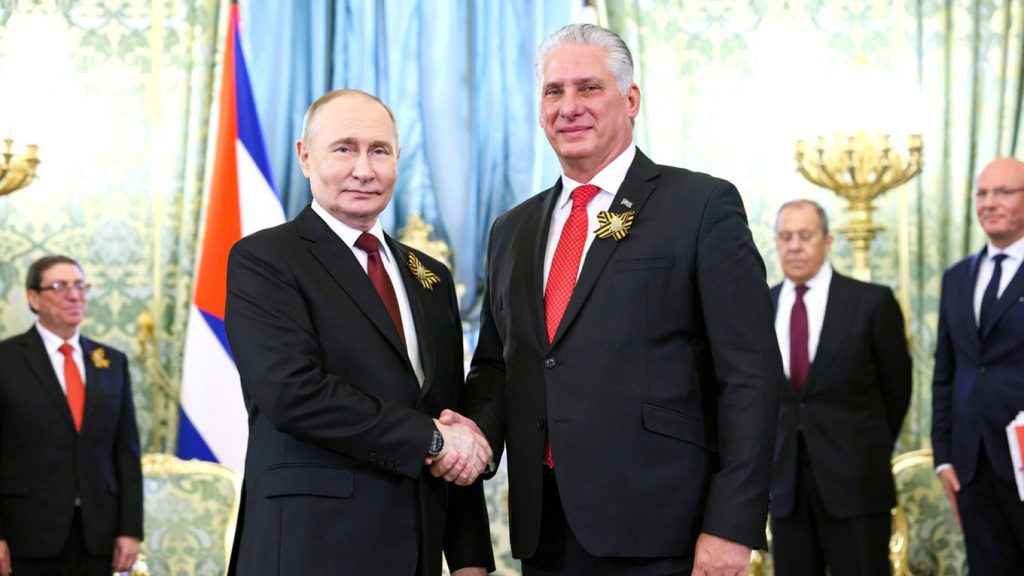Four Russian naval vessels, including a nuclear-powered submarine, will be in Cuba from Wednesday to Monday for joint exercises in the Caribbean Sea.
Despite the capability of some of the vessels to carry nuclear-capable long-range missiles, Havana and Washington have both stated that there is no direct threat to the United States.
While the location of these drills may evoke memories of the 1962 Cuban Missile Crisis, experts have informed The Moscow Times that Russia’s objective is to send a message to the West without escalating tensions.
The exercises also serve to project an image of Russia as a global power with influence beyond its borders.
Though relations between Havana and Moscow are not as close as during the Cold War, the two nations remain allies. They share a strong criticism of the sanctions imposed on each other and the expansion of NATO. Havana has also supported Russia’s right to “self-defense” against NATO following its invasion of Ukraine in 2022, but has not endorsed the move.
Emanuel Pietrobon, an analyst specializing in Latin America and the post-Soviet space, told The Moscow Times, “Cuba is Russia’s most important partner in the Western Hemisphere from a purely geopolitical and geostrategic point of view.
Cuba’s proximity to the U.S. makes it an ideal location for Russia to conduct electronic warfare and gather intelligence by intercepting signals from the U.S. Navy and its command centers, according to Pietrobon.
For Cuba, Russia is a crucial partner in maintaining domestic and economic stability. In 2014, Moscow forgave 90% of Cuba’s $35.2 billion debt owed to the Soviet Union.

Annual Russian naval exercises in Cuba have been held between 2013 and 2020, making this week’s port call “routine” according to Washington.
Despite Russia’s invasion of Ukraine and President Vladimir Putin’s recent threat to supply unspecified countries with weapons, experts have stated that the significance of the naval exercises remains unchanged.
Pietrobon said, “The meaning of this naval presence is essentially no different from the past: Russia wants to show that its navy is able to cross the oceans and reach Florida’s coasts.”
The presence of the Kazan nuclear-powered submarine has garnered attention, though it is not carrying nuclear weapons. It is capable of firing Kalibr cruise missiles, which have a range of up to 2,500 kilometers and can be equipped with nuclear warheads.
The Frigate Admiral Gorshkov, carrying hypersonic Tsirkon missiles, which the Kremlin claims are nuclear-capable, will also be present. The Akademik Pashin refueling tanker and Nikolay Chiker tugboat will support the Frigate.
The U.S. will closely monitor Russia’s activities in the Caribbean Sea. Two destroyers and two ships with sonar equipment will shadow the submarine, while another destroyer and a cutter from the U.S. Coast Guard will follow the remaining vessels.
All four vessels belong to Russia’s Northern Fleet, headquartered in the Arctic city of Severomorsk, over 8,500 kilometers from Cuba. During their journey across the Atlantic Ocean, the vessels conducted simulated exercises, practicing hitting targets with long-distance missiles.
Katarzyna Zysk, a professor at the Norwegian Institute for Defense Studies, told The Moscow Times that the decision to send parts of the Northern Fleet was likely practical. “The Northern Fleet is the strongest part of the Russian Navy where some of the most capable warships are deployed,” she said.
Zysk also noted that recent Russian naval exercises have focused on deploying warships from one remote theater of operations to another, as Russia’s naval forces are dispersed between the Arctic, Pacific, Baltic, and Black Sea theaters.
Deploying the ships so far from Russia could also serve a domestic propaganda purpose, according to Zysk, by portraying Russia “as a global power, not completely bogged down and consumed by the disastrous war in Ukraine.
According to the U.S. State Department, this week’s drills are part of a build-up to more Russian air force and naval exercises in the Caribbean over the summer, before a larger global naval exercise in the fall.









![Ukrainian servicemen carry the coffin of combat medic Maria-Khrystyna Dvoinik, who was killed during an evacuation of wounded soldiers from the front line in Donetsk, November 15, 2024 [Sergey Dolzhenko/EPA]](https://i2.wp.com/www.aljazeera.com/wp-content/uploads/2024/11/12630491-1731735153.jpg?resize=770%2C513&quality=80&w=1200&resize=1200,0)
